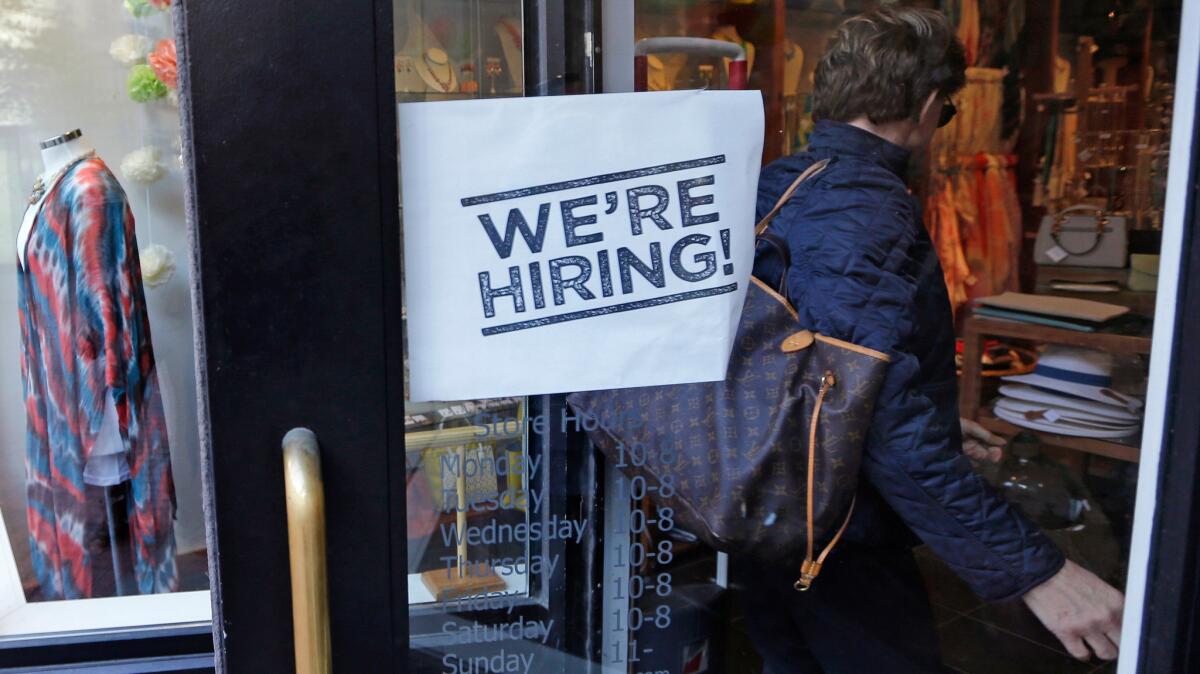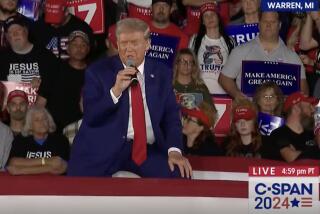The economic recovery just turned 7, and here’s why it feels so weak

- Share via
Though you’d never know it from listening to the presidential candidates, the current U.S. economic expansion is the fourth-longest since the end of World War II.
But a startlingly bad jobs report last week raised new concerns about the state of the economy, even as it probably delayed another interest rate hike.
As it’s done for the last seven years since the end of the Great Recession, the economy has been sending mixed signals. Wages are rising and unemployment remains low, at 4.7%. But job growth sputtered in May and total economic output is expected to grow only about 2% this year, well below the 3.4% average from 1950 to 2007.
“We’ve come a long way from the bottom of 2009,” said David Shulman, senior economist at the UCLA Anderson Forecast. “But compared to the historical growth track, we’re so far below it that it’s staggering, and that’s the unease the public feels about the economy.”
Here’s a look at some of the key indications of economic health.
Overall growth remains subpar
The economy has been growing for 84 months, a stretch that is well above the 58-month average post-World War II expansion.
But the pace of this recovery has been the slowest, with average annual growth of about 2.1%.
That’s made the economic situation precarious, said Douglas Holtz-Eakin, president of the conservative-leaning American Action Forum think tank and former director of the Congressional Budget Office.
“When you’re growing slowly and bad things happen, as they do, you get knocked toward zero too quickly,” Holtz-Eakin said.
A recession generally is defined as two consecutive quarters of economic contraction. So a weak quarter caused by unusually bad weather or global tumult starts raising recession fears.
That’s what happened in the first quarter of this year, when a steep drop in business investment triggered largely by low oil prices helped cause a disappointing annual growth rate of 0.8%.
As a result, 2016 is the fifth in seven years that the U.S. has had at least one quarter in which the economy grew at an annual rate of less than 1%.
But as has also happened in the past, the economy quickly rebounded. Consumer spending in April jumped the most in seven years and growth this quarter is expected to be about 2.5%.
Bottom line: The recession risk will remain low for the next couple of years, economists said.
“The odds are high this is going to be rivaling the longest expansion we’ve ever enjoyed,” said Mark Zandi, chief economist at Moody’s Analytics.
Inflation has started stirring
A big reason Federal Reserve policymakers are considering another interest rate hike despite the slow growth is the fear that prices could start increasing too rapidly.
Inflation has been tame throughout the recovery, most recently because of lower oil prices. But core inflation, which excludes the often-volatile prices of oil and food, has been creeping up toward the Fed’s annual target of 2%.
It hasn’t been at that level since 2012.
Low prices are good for consumers, but low inflation also can reflect weak wage growth. So the Fed wants inflation in what it views as a sweet spot -- rising enough to help boost pay without going up so much that food and other goods become unaffordable.
It takes a while for higher interest rates to affect the economy, so the Fed needs to act before prices rise too much if it wants to keep inflation in check. Inflation could be running at an annual rate of 3% next year, Shulman said.
Because prices for oil and other commodities have been low, higher inflation would be triggered in large part by rising worker pay and compensation.
Zandi also thinks inflation could soon exceed the Fed’s preferred level. But because there’s been so little inflation in recent years, that might not be so bad -- particularly if it reflects higher wage growth, he said.
He anticipates the Fed will move slowly on interest rate hikes, even if inflation accelerates quickly.
“I think the Fed is happy to … let the economy run hot for a while,” Zandi said.
Rising wages: the key to labor market
The unemployment rate has been cut by more than half since its recent peak of 10% in late 2009. But the labor market continues to have unsettling ups and downs.
After solid job growth in recent years, the pace of hiring declined sharply this spring.
On Friday, the Labor Department said the economy added just 38,000 net new jobs in May, the worst performance since 2010, although the figure was skewed somewhat by a Verizon strike that just ended.
Still, the economy has added about 2.4 million net jobs in the 12 months that ended May 31 and more than 14 million since the labor market bottomed out about six years ago.
“The economy’s very close to full employment,” Zandi said.
But wages have been slow to rise. And economists said the labor market won’t be fully healed until workers see their paychecks growing substantially.
There are signs that is starting to happen. Job growth has reduced the number of unemployed Americans and put pressure on employers to raise wages to lure and keep workers.
Average hourly earnings increased 2.5% for the 12 months ended May 31. That’s slightly lower than the annual pace at the end of last year, but still a positive sign after stretches of less than 2% growth during the recovery.
“Wages are beginning to pick up,” Shulman said.
He expects the pace to be above 3% by the end of the year. Fed policymakers are watching wages and the percentage of working-age Americans in the labor force, which has been near historic lows, as they weigh a rate hike.
Analysts said last week’s poor jobs report most likely means Fed officials won’t enact a hike when they meet June 14-15. But a better jobs report next month could lead to a hike in July.
Housing has more to give
The housing market’s contribution to the economic recovery has been disappointing.
Despite unusually low mortgage rates, demand for single-family homes has been weak, especially among young adults, many of whom are still living with their parents.
Builders, meanwhile, have complained about soaring regulatory costs and a shortage of affordable lots. Their response has been to build more apartments and fewer but larger homes that yield bigger returns. Lenders, too, have been going after higher-end customers, making more jumbo loans. All that hasn’t helped the first-time buyer or the broader housing market.
The good news, analysts said, is that things are beginning to change.
Builders are showing more interest in single-family dwellings, Wells Fargo senior economist Mark Vitner said. “Apartment rents in cities are so expensive, there’s a return to the suburbs for affordability.”
Robert Dietz, chief economist at the National Assn. of Home Builders, sees the share of residential construction and investment to overall economic output returning to a more healthy level of about 5%. It was just 3.4% in the most recent first quarter.
On the supply side, builders are finding it harder to get financing for multifamily properties. So as demand for traditional homes rises, developers can be expected to follow buyers to more spacious locales in the burbs.
What’s more, Dietz said, there’s a need to replace old housing stock, so-called tear-down construction, which will help increase single-family starts.
“The fundamentals are there. It’s just going to take time,” he said.
Troubles in the global economy
Economist Catherine Mann said the world economy is stuck in a trap of slow investment, sluggish trade and low productivity gains. And there are significant risks ahead.
There’s the lingering uncertainty over China’s economic slowdown, which clobbered financial markets early this year. Currency swings and interest rate hikes by the Federal Reserve could roil countries with large debts. Political turmoil in the Middle East and North Africa could further disrupt oil markets and propel outflows of refugees into Europe.
And then there’s the so-called Brexit referendum June 23. If Britain votes to leave the European Union, the hit to the global economy could be as powerful as a hard landing in China, said Mann, the chief economist at the Organization for Economic Cooperation and Development.
“The consequences of the trap and the risks is that we’ve broken our promises to the young, the old and the investors,” she said at a news briefing last week.
For the U.S., the global malaise has been felt prominently in softer foreign earnings and trade, which has hurt domestic manufacturing and exporters. American exports in the first quarter fell 8% from the same period in 2015.
Sara Johnson, senior research director at IHS Global Insight, is forecasting U.S. exports will rebound next year, but will continue to be eclipsed by imports. So trade will remain a small drag on the American economy through at least 2018.
Problems cyclical in nature, like excess commodity supplies, may pass with time, but not so with structural challenges. They include an aging population and declining labor force growth, and issues involving infrastructure and education -- all of which, unless dealt with, will keep the U.S. and global economies from reaching their full potential.
MORE FROM BUSINESS
Doing some drunk driving, stone cold sober
‘Turtles’ take over box office, ‘Me Before You’ surprises and ‘Popstar’ doesn’t pop
Do drought-related water restrictions take precedence over lease requirements?
Follow @JimPuzzanghera on Twitter
More to Read
Inside the business of entertainment
The Wide Shot brings you news, analysis and insights on everything from streaming wars to production — and what it all means for the future.
You may occasionally receive promotional content from the Los Angeles Times.












